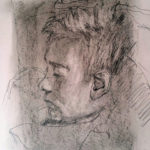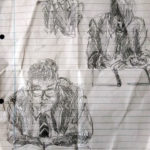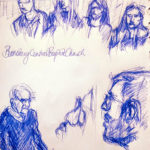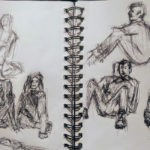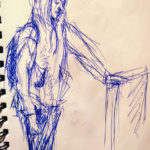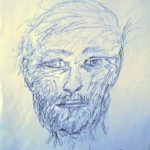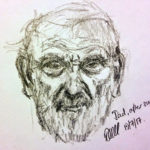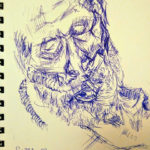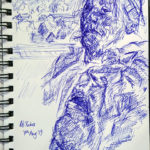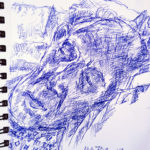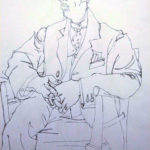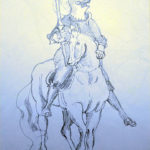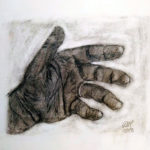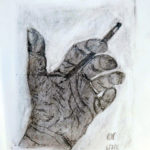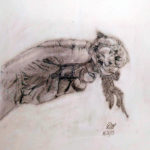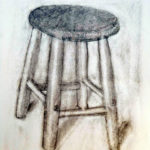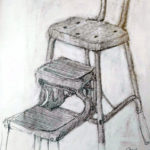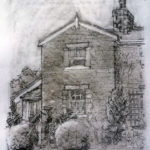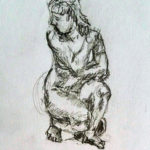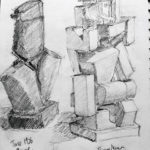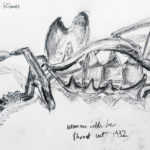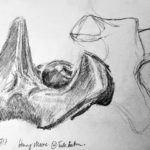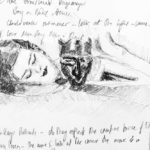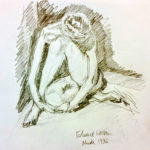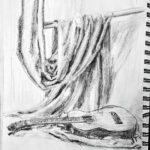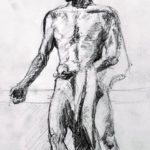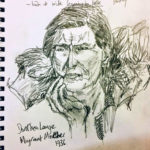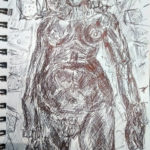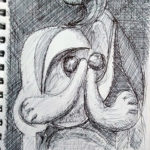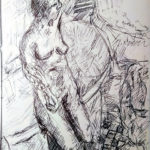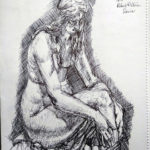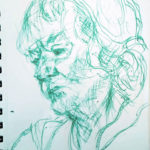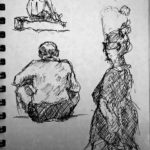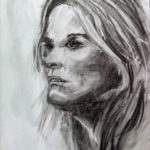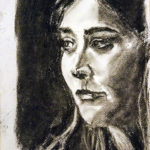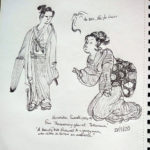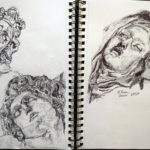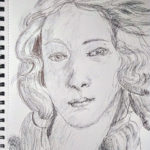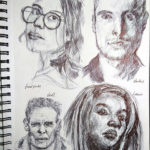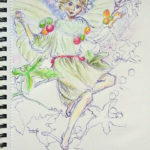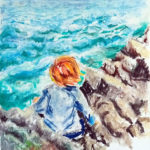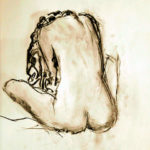Learning to Draw
Learning to Look
This is a picture of my son, the first ‘live’ portrait I attempted after undertaking Betty Edward’s instructions on portraits in her book, Drawing with the Right Side of the Brain. I know the ear is in the wrong place, but other than that it is pretty draw-droppingly amazing; at least I found it so when I first finished it. It was an utter step change in what I thought I could do and what I expected from drawing. It was actually the face of an actual person! But it also showed mood. I didn’t ‘draw in’ mood, I just drew what was there, what I saw, and mood came out.
I wrote an article, called Learning to Look, for the school magazine in my last years of teaching. It reflects more my role as an RE teacher than a fledgling artist, but looking back I see signs of me wanting to move in a different direction, for which the art was a catalyst. And it does capture what Betty’s book means to me.
“The artist David Hockney would explain my desire to learn to draw thus: “The urge to represent is deep within us”. Perhaps this urge is evident in the love that young children have of drawing and painting, something which is all too easily snuffed out in early adolescence when so many children pick up the message they cannot draw. Some think this ‘death of art’ happens then because it is the time when the faculties of our brain responsible for verbalising, analysing, abstracting and rationalising start to dominate those brain faculties which perceive space, line, proportion and relationship which are necessary for the depiction of a realistic, perceived image. Such is the view of Betty Edwards, art teacher and author of the book Drawing from the Right Side of the Brain, who has helped thousands (re-)discover hidden artistic talents, including my own.
“…Edwards teaches you to value the impression that you make. It is your impression; when you draw somebody, it is not just a copy of them, it is your depiction of them. Even if it is a very accurate drawing, you have changed them slightly, “Thus,” says Edwards, “paradoxically, the more clearly you can perceive and draw what you see in the external world, the more clearly the viewer can see you…” Moreover, by doing so you have connected with what you have depicted; you have mixed up a little bit of yourself in that depiction. Therein lies its value.
“…I have been trying to suggest that, if the goal is to become more compassionate, then learning to look is fundamental, and art – whether creating or appreciating it – can greatly aid that process. Edwards comments, “…I venture to say that learning to draw always seems to help and never to harm. My students’ most frequent comment after learning to draw is ‘Life seems much richer now that I am seeing more.’ That may be reason enough to learn to draw.”
I like to think I was a loss to the teaching profession, especially when I had just discovered something that all young people need to hear and much of our school system seems wanton in giving them.
Preliminary tasks
One of the first tasks Betty asks you to do is simply sign your name. I enjoyed the signature task, it brought back memories. It reminded me of when, in my mid-teens, I decided to improve my shambolic handwriting, developing a style I would describe as more ‘flouncy and swirly’ than before… and as a result I really enjoyed the physical process of writing and became proud of my signature. Another consequence was that I got into letter-writing (mostly to girls I had crushes on). I found something quite creative and cathartic in the process of letter-writing. Perhaps this was where I channelled the natural childhood urge to reach out graphically and connect with the world around me, that Betty says all children have, which I had lost when I gave up drawing as a child.
I certainly think that life would have turned out very differently had I nurtured my artistic/creative side earlier, before the age of 44, but such regretful hindsight has limited uses. I think I would have benefitted by a more unified body and spirit, greater confidence, greater ownership of feelings and expression. Does this make you happier? Are artists more well-balanced and more comfortable in their own skin than others? Debatable, but, despite the obvious outliers, I think I would still say they were.
Another preliminary task was to draw picture of the face from memory. I drew my father and it was a natural choice. When I was six I painted a picture of my father – he had very strong features – a big bushy beard, prominent nose and a comb-over (the stereotypical seventies physics teacher), I wish I still had that picture. I’ve included my ‘face from memory’ here, and another quick sketch of him I drew after supper one evening when I had become a bit more practiced. He said he thought I made him look like Jeremy Corbyn (despite JC not being the politician most well-known for his comb-over).
I’ve decided to include a couple of sketches of Dad in Yeovil hospital, in his last days, in the hot summer of 2019. It felt very strange to sketch dad as he was dying – I’m not sure what the nurses thought – but there was little else to do. And drawing him seemed a better way to be with him, in his last moments slipping in and out consciousness, than distracting myself with a book or a crossword. These sketches, and others I have done, are often much better at helping me recall a memory, a mood, a feeling, more directly and viscerally than a written diary entry. I developed the habit of ‘sketching to readjust’ and this I think has develop a more authentic voice in my art, where ambiguity and working through events and their repercussions are key components. I have found sketching a good route to connecting with the world, to situations, emotions – and people – when it is easy to remain separated and sealed off from them.
Engaging the right side of the brain
It is Betty’s contention that the left side of the brain tends to dominate the right side of the brain to the detriment of your drawing, another reason why children give up art, when their verbal and reasoning faculties begin to overtake their sensing/perceiving ones. I think this is widely accepted both in the world of art and neuroscience. Whatever the truth of it, her method had great results on my drawing.
She is a great advocate of copying pictures that are upside down, the premise being that when things are upside down you don’t recognise ‘things as things’ (trying to draw ‘things’ is often a road to artistic dissatisfaction…), and so you concentrate on the up/down/left right of the line or the gradient of the curve. She gets you to copy what is a relatively complicated portrait of Igor Stravinsky by Picasso upside-down, and the result was pretty amazing. “You will probably find…” is a phrase she uses a lot; and she is usually right. “You will probably find the result very successful, but that it breaks down a little with the features of the face and the fingers.” Again she was right, suggesting that these objects even when upside down are still recognised as ‘things’ by the left side of the brain instead of a collection of lines in spatial relation to one another. With this method I found that I could copy reasonably well, and it was VERY satisfying.
To encourage you to ‘just follow the line’ and not draw ‘things’, Betty introduces the practice she calls pure contour drawing. This experience of intense looking requires you to keep your eyes on the subject for the duration of the sketch. It was a very absorbing and meditative exercise in itself, and the objective is not to create a ‘beautiful picture’. The practice does still you, and I’m sure it did train my eyes to look more and not flit quite so much. My eyes do flit (all of ours do), but my mind also flits and finds it difficult to rest. This is why art tends to be good for me. I play musical instruments, in its own way cathartic and releasing, but music tends to ‘stir me up’ when drawing tends to ‘calm me down’. When I went into the life room a while later, it was literally that – it gave me life, the intensity of the practice, surrounded by silent crowd intensely looking and furtively scratching away, was pure meditation.
Also she encouraged the use of a defined picture plane with crosshairs to support the placing of elements in a picture. Instead of starting with an intimidating blank piece of paper, she got you to use a shaded background, erasing areas around a subject or to show highlights intensifying other areas with the pencil to increase shadow. Again, the results were very effective, and I suddenly felt ‘like an artist’ (belying my own misconception that to be ‘an artist’ you need to be good at figurative representation – but I’ll leave that for another time).
Drawing in galleries and elsewhere
At the very beginning, I needed the support of picture planes and crosshairs, whereas now I don’t use them. I just find my way around a view and things more naturally fit together like a jigsaw. I first felt this independence from picture planes and crosshairs when I drew a Giacometti geometric sculpture on a visit to an exhibition at the Tate.
Sketching in galleries was a huge step forward for me, and when I began the practice my inner critic used to scream “How DARE you think you can sketch in a public place, what a FOOL you must look like!! Do you honestly think you’re GOOD enough??!” Of course, nobody bats and eyelid and some are even quite interested and encouraging. And true artists don’t care what other people think, they just do what they have to do, “Hang the world…!” they say, even though they’d like to hang some of their paintings and then for people buy them. This sketch of a sculpture of Venus in one of the main atria of the British Museum is one of the first public place sketches I did – looking at it brings back all excitement and nervous tension I felt.
It was even more of triumph over mental blocks and internal critics to start people-watching and sketching out-and-about in public. I started sketching in parks on dog walks at a very safe distance from my subjects. I used to sketch people on trains, sometimes secretly and then I began to ask people if it would be okay to draw them, “I’m just learning and need the practice…” I used to say. It often led to some nice conversations.
As I said, sketching people out and about is not without its trepidation. One such moment when my trepidation appeared to be validated happened one afternoon in May 2022, after I had been sketching in my favourite park in Ronda, the Alameda del Tajo, close to the mountain village where I had recently bought a house. I was quite taken by the sight of a young Northern European couple on holiday sitting in the same outdoor café. The man looked like a young Woody Harrelson, and his partner like Brigitte Bardot. Neither were sitting still enough to make them easy to draw, so I just sketched their hats. Later in the day I was walking through the streets and the same man came towards me. “You were sketching us in the park earlier weren’t you?” he said pointedly, as the panic started to rise within me. “Er, yes…” I admitted, “I just sketched your hats, I liked their shapes…” slightly relieved that I didn’t have to admit that I found them ‘a beautiful couple’… “Can I have a look?” he asked. I reticently handed over my sketch book and flicked through it and said, “I think you are connecting with the world through your pen… I like that… I’m an art teacher from Holland, by the way…”
Connecting with the world through your pen has been a hugely valuable and exciting process. But I realise that, while useful in itself, there is another door that this process can unlock, a door which I have yet to really go through. On a visit to Switzerland in summer 2019, I spent a few hours at an artificial beach in Geneva, filling in time before my flight. I sat sketching on a bench – a portly old man in his swimming costume, a mum in a billowing beach dress, children playing on an inflatable diving board moored in the lake. I was vaguely aware I had been joined by a scruffy middle-aged man on my bench, who eventually broke into conversation. It turned out he was an abstract artist himself and was fascinated by my sketching. “What’s important,” he advised me, “is what you do with them…” exhorting me to take them back to the studio and transform them into something which was my own. This for me is the hardest part of creativity, and is something that even now I shy away from. Learning to draw is one thing, connecting with the world around you is beneficial in many ways, but the real part of creativity is having the courage to take these skills, take this connection, and transform them into something which is your own experience and expression of the world, and yourself.
A few more portraits and things…


